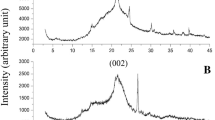Abstract
Production potential of furfural from sugarcane bagasse was studied in industrial sample and two sugarcane varieties CoJ 85 and CoJ 88. For this the preparation of fine bagasse sample of two varieties similar to industrial sample had been standardized in the laboratory. Then bagasse obtained from sugar industry, sugarcane varieties CoJ 85 and CoJ 88 was treated with different acids (acetic acid, formic acid, hydrochloric acid and sulfuric acid) with variable concentrations (1 and 2 % of each acid) and autoclaved for 30, 60 and 90 minutes with solid-liquid ratio of 1:15 at 1100C temperature and 1.05 kgcm−2 steam pressure for furfural production. The reaction of bagasse with 2 % H2SO4 gave the highest yield of furfural from bagasse of CoJ 88 variety with the time interval of 90 minutes. Furfural can be converted to furfuryl alcohol with flammable hydrogen gas and requires pressure equipment. This thus limits the utility of this process for smaller scale units requiring gram equivalents of furfuryl alcohol that may be required for further applications. Therefore in the present investigation, the inexpensive reagents thiourea dioxide (TUDO), hydroxymethane sulfinic acid (HMS), Zn/HCl and Sn/HCl were tested for the reduction of furfural to furfuryl alcohol. Among all these reagents, Sn/HCl has been found to give the best result where furfural gets reduced to the furfuryl alcohol almost in quantitative yield.
Similar content being viewed by others
References
Goering HK, Van Soest PJ (1970) Forage Fibre analysis. Agricultural Handbook. No. 379.
Goldstein IS (1981) “Organic Chemicals from Biomass”; CRC Press: Cleveland.
Grethlein HE (1978) Hydrolysis of agricultural and forest products by using acid hydrolysis. Biotechnol Bioeng 20: 503.
Horwitz W (1980) Official Methods of Analysis (13th edition). Assoc. Official Analytical Chemists, Washington, D. C.
Sen KC, Rai SN, Ranjhan SK (1978) Nutritive value of Indian feeds and the feeding of animals. pp 88. ICAR, New Delhi.
Singh A, Das K, Sharma DK (1984) Integrated process for production of xylose, furfural and glucose from bagasse by two-step acid hydrolysis. Ind Eng Chem Prod Res Dev 23: 257–262.
Singh A, Das K, Sharma DK (1984) Agric. Waste, 9: 1–15.
Solomon S, Singh (1995) Sugarcane diversification. “Recent developments and future prospects in sugarcane”. In: Singh G B and Solomon S (ed) Agro-Industrial Alternatives. Oxford IBH, New Delhi.
Upadhiaya UC (1996) Cogeneration of steam and electric power. Sugar Y Azucar 91(3): 30–36.
Uppal SK, Thind KS, Gill RS (2006) Feasibility of ethanol production from cultivated sugarcane varieties of Punjab (India). Sugar Tech 8(2&3): 180–183.
Win DT (2005) Furfural-Gold from Garbage. AU Jour Tech 8(4): 185–90.
Author information
Authors and Affiliations
Corresponding author
Rights and permissions
About this article
Cite this article
Uppal, S.K., Gupta, R., Dhillon, R.S. et al. Potential of sugarcane bagasse for production of furfural and its derivatives. Sugar Tech 10, 298–301 (2008). https://doi.org/10.1007/s12355-008-0053-6
Received:
Revised:
Accepted:
Published:
Issue Date:
DOI: https://doi.org/10.1007/s12355-008-0053-6




